“Terminating a Revolution in Guatemala-A view from Guatemala”, (1954)
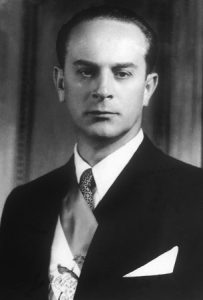
JACOBO ARBENZ GUZMAN
(1913-1971). Guatemalan politician. Photographed while President of Guatemala, 1951-1954.
In 1951, Colonel Jacobo Arbenz Guzman Bermejo succeeded to Guatemala’s presidency with over 60 percent of the vote and a peaceful transition to power. Although Arbenz did not posed a threat to the US before getting elected, during his presidency, he enacted an agrarian reform law that expropriated most of the land from the United Fruit Company (US owned business). This action and the appointment of communists to his government made him an enemy to the US which eventually lead to the CIA being involved in his coup that overthrew him in 1954. Luis Cardoza y Aragon was a Guatemalan poet who worked for Arbenz as an ambassador and he openly accuses the US as imperialist and hypocrite during an interview. He says during the interview that Guatemala did not posed any threat to the US and the intentions of Arbenz and his party were solely to the well-being of their citizens. He called Eisenhower a “beast” that destroyed the hopes of a small poor nation that was progressing towards liberty and freedom. Aragon’s comments project the perspective of the Guatemalan people who see American intervention as destructive and illegitimate because they claim they fight against communism but at the same time, the US participates in unethical involvements across Latin America that contradict their own justification.
Cuba, Latin American Communists, and the Sino-Soviet Struggle for Influence, (1963)
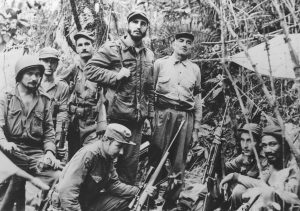
December 1982, Cuba — This photo, filed June 1957, is believed to be the only existing one of Fidel Castro, leader of Cuba’s revolutionary forces, and members of his staff and troop commanders made at a secret base near the coast. The group includes five captains, the entire top command of the guerilla army. From right are Capt. Juan Almeida, Capt. George Sotus, Fidel Castro, Capt. Raul Castro, the leader’s younger brother (kneeling in the foreground), Capt. Guillermo Garcia, (wearing helmet at left), Lt. Universo Sanchez, Castro’s adjutant, (third from left) and Dr. Ernesto Guevara, (second from left), the official physician of the rebel army. — Image by © Bettmann/CORBIS
After Fidel Castro successfully seized power in Cuba on January 1959, the US-Cuban relations basically came to an end with an economic embargo. The CIA increased surveillance on the island and came up with a report in 1963 which described Fidel Castro’s relationship with Soviet Russia and their plans to increase communist influence in Latin America. Something worth mentioning from the CIA report is that Castro’s relationship with the Soviets was not always perfect. This is because Castro wanted to impose communism by force in Latin America through revolutions and that idea wasn’t usually shared among the Soviets but, their motivation was the same which was to reduce the power of the US in the region. The report also talks about significant events such as the Bay of Pigs and the Cuban Missile Crisis. In 1962, the Cuban Missile Crisis shocked the US and its report reveal the discomfort of the US towards Castro’s regime in Cuba. The uncertainty of Castro’s regime served as motivation to find a way to overthrow or eliminate him. The report also shows the devotion and preparation the US has been anticipating towards stopping any type of revolution or communist insurgency in Latin America.
“Juan Bosch, deposed president of the Dominican Republic, denouncing U.S. intervention”, photo (1965)
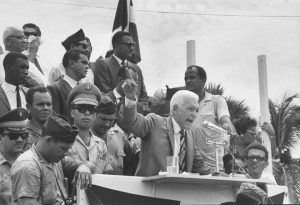
Ex-Pres. of Puerto Rico Juan Bosch returning form 2 year exile denounces the US. (Photo by Michael Rougier//Time Life Pictures/Getty Images)
In 1965, Juan Bosch Gavino, a Dominican politician, delivered a speech to his supporters, also known as Constitutionalists, who wanted to attempt to restore him to power through a coup. Juan Bosch successfully organized president Rafael Trujillo’s assassination in 1961 and won his first presidential election in 1962 but overthrown one year later. Bosh returned to the Dominican Republic in 1965 to reclaim the presidency. He was backed up by revolutionaries, but his efforts were stopped by Lyndon B. Johnson who dispatched Marines on April 28, 1965. US intervention in Dominican Republic is another example of US fear towards communism in Latin America. The reason for the military invasion was to prevent another Cuba to happen but instead, that created major discomfort towards the US because it was seen as imperialist. Once again, the US proved to go against their own words when it involved helping Latin America falling to communism. The decisions Johnson made eventually lead to more insurgencies in Latin America near the end of the Cold War.
“Pinochet rides through the streets of Santiago in a parade celebrating the eleventh anniversary of the military coup d’etat”, Photo (September 1984)
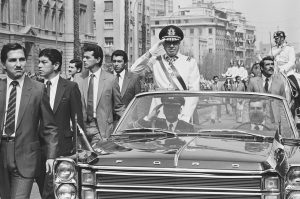
11 Sep 1984, Santiago, Chile — General Augusto Pinochet rides through the streets of Santiago in a parade celebrating the 11th anniversary of the coup d’etat in Chile. — Image by © Carlos Carrion/Sygma/Corbis
Augusto Pinochet, former Chilean president, celebrates the anniversary, during a military parade, his successful coup against Salvador Allende in September 1984. Pinochet’s coup was backed by the United States and even though Pinochet was accused of human rights abuses, the US ignored them for several years. The US also ignored corruption allegations and inequality in Chile under Pinochet’s regime. The blind eye of the United States towards the Pinochet regime is significant to understand US-Latin American relations during the Cold War. Since Cuba, the US has been very cautious on what presidents they support and since Pinochet declared himself an ally to the US, they backed him before and after his coup. The blind eye is also another evidence of US hypocrisy when it involves Latin American relations. The US consistently accused Cuba of human rights violations under the Castro regime but never addressed Pinochet’s abuses because he was considered an ally. Although the US didn’t involve themselves military in Chile, they supported dictators that created long-lasting inequality and suffering which the US has been condemning to other nations but not to their allies.
Reagan, Ronald. “The Fear of Communism in Central America”, (1984)
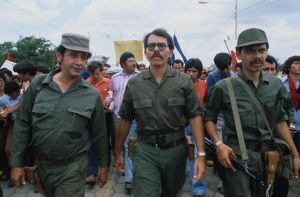
04 Aug 1979, Managua, Nicaragua — Managua, Nicaragua: Daniel Ortega (L), member of Nicaragua’s junta, leads thousands of Nicaraguans through the streets of the capital in demonstration of support for the new Sandinista government. — Image by © Bettmann/CORBIS
During the last stages of the Cold War, the governments of Nicaragua and El Salvador were fighting civil wars against communist uprising or guerrillas. In Nicaragua, the popular uprising known as the Sandinistas, overthrew US backed president Anastasio Somoza on July 1979. El Salvador was just starting its civil war when US president Ronald Reagan requested attention from the public about the issue on a televised speech in May 9, 1984. On his speech, Reagan emphasized that the US will never be the aggressor and will never send troops to Central America but, he also said that it’s America’s interest to protect its friends and preserve freedom. Raegan’s oxymoron reflects America’s foreign policy towards Latin America during the Cold War years basically getting physically involved in situations while justifying it with vague rationale like the protection of liberty or human rights. Reagan also mentions in his speech that Central America is of vital importance because if communism wins, it can destabilize the whole region while threating the security of the US with more Soviet military bases. This once again proves the fear the US had of communism spread in Latin America because of its proximity on the American border.
